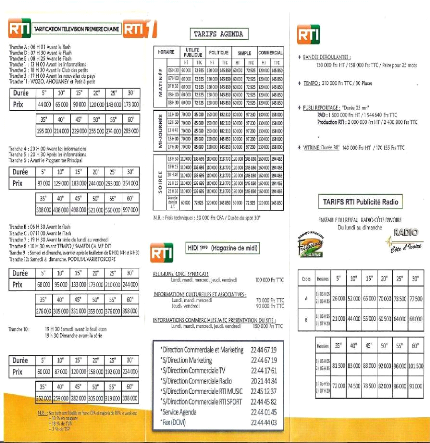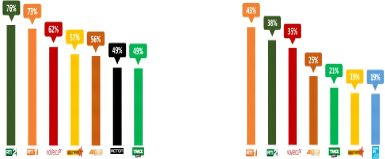F. IDENTIFICATION OF SURVEYS ACCORDING TO THEIR
READING FROM THE PRESS
1. Do you read newspapers and magazines? If not, please ignore
the sub-questions!
D YES D NO
D Other (s) to be specified
2. Which newspaper do you read the most?
D Fraternité Matin
D Notre Voix
D Soir Info
D Le Patriote
D Super sport
D Other (s) to be specified
3. Which magazine do you read the most?
D Gbich
D PME Magazine D Allo Police
D Jeune Afrique
D Other (s) to be specified
XXIII
THANK YOU FOR YOUR COLLABORATION
XXIV
APPENDIX 2 : TELEVISION PRICING (FIRST CHANNEL)

APPENDIX 3: 2019 AUDIENCE SURVEY

XXV
APPENDIX 4: 2019 RADIO FREQUENCY LISTENING RATE SURVEY

XXVI
APPENDIX 5: AVERAGE NUMBER OF COPIES PER DAILY (2019
SURVEY)

XXVII
TABLE OF CONTENTS
DEDICATION I
ACKNOWLEDGEMENTS II
CONTENTS III
LIST OF ACRONYMS AND ABBREVIATIONS IV
LIST OF FIGURES V
LIST OF GRAPHS VI
LIST OF TABLES VII
GLOSSARY VIII
FOREWORD IX
ABSTRACT XI
GENERAL INTRODUCTION 1
PART ONE : THEORETICAL FRAMEWORK OF THE STUDY 3
CHAPTER I : THEORETICAL APPROACH 4
I.1. Justification for the choice of theme 4
I.2. Interests of the study 4
I.2.1. Personal interest 4
I.2.2. Scientific interest 4
I.2.3. Interest in INP-HB 5
I.2.4. Economic interest 5
I.3. Literature review 5
I.3.1. Theoretical books 5
I.3.2. Empirical works 6
I.4. Objectives of the study 8
I.4.1. Main objective 8
I.4.2. Specific objectives 8
I.5. Assumptions of the study 8
I.5.1. General hypothesis 8
I.2.5. Specific hypotheses 8
CHAPTER II : CONCEPTUAL APPROACH 9
II.1.
XXVIII
Strategy 9
II.2. Communication 10
II.3. Promotion 11
II.4. Marketing communication strategy 11
II.4.1. Media communication 11
II.4.2. Non-media communication 11
II.5. Stages of a communication strategy (kotler et al. 2009)
12
II.5.1. Identify the problem 12
II.5.2. Identify targets 12
II.5.3. Formulate the objective 12
II.5.4. Formulate the message 13
II.5.5. Choose means of communication 13
II.5.6. Budget determination 14
II.5.7. Determination of the communication plan 14
II.5.8. Measure the results 15
PART TWO : PRATICAL FRAMEWORK OF THE STUDY 16
CHAPTER III : STUDY METHODOLOGY 17
III.1. Data collection methods 17
III.1.1. Participant observation 17
III.1.2. Literature search 17
III.1.3. Sampling 18
III.1.3.1. Survey frame 18
1II.1.3.2. Sample size 18
III.1.4. Conduct of the survey 18
III.1.4.1. Survey 19
III.1.4.2. Counting of the questionnaire 19
III.1.4.3. Data processing 19
III.2. Conditions for carrying out the study 19
III.3. Environmental analysis methods 20
III.3.1. PESTEL analysis 20
III.3.2. SWOT matrix 22
CHAPTER IV : PRESENTATION OF RESULTS AND PROPOSALS 23
IV.1. Presentation of the questionnaire results 23
IV.1.1. Identification of the profile of respondents 23
IV.1.1.1. The gender of the respondents 23
XXIX
IV.1.1.2. age range 23
IV.1.1.3. Socio-Professional Category 24
IV.1.1.4. Geographic area of the study 24
IV.1.2. Identification of the Polytechnic Language Center
25
IV.1.2.1. Notoriety of the Polytechnic Language Center 25
IV.1.2.2. Communication channels 25
IV.1.2.3. Geographic location 26
IV.1.2.4. Awareness of services 26
IV.1.2.5. Attendance at the Polytechnic Language Center 27
IV.1.3. Television audience analysis 27
IV.1.3.1. Television audience 27
IV.1.3.2. Frequency with television 28
IV.1.3.3. Television viewing hours 28
IV.1.3.4. Audience rate of television channels 29
IV.1.3.5. Audience rate of programs watched on television
29
IV.1.4. Internet usage analysis 30
IV.1.4.1. Familiarity with the internet 30
IV.1.4.2. Frequency of Internet use 30
IV.1.4.3. Internet connection days 31
IV.1.4.4. Internet connection hours 31
IV.1.4.5. Familiarity with social networks 32
IV.1.4.6. Familiarity with different social networks 32
IV.1.4.7. Most used social networks 33
IV.1.4.8. Breakdown of the target according to the most
visited sites 33
IV.1.5. Radio audience analysis 34
IV.1.5.1. Familiarity with radio 34
IV.1.5.2. Radio listening frequency 34
IV.1.5.3. Breakdown by radio listening hours 35
IV.1.5.4. Breakdown by radio channels listened to 35
IV.1.6. Analysis of the press audience 36
IV.1.6.1. Familiarity with the press 36
IV.1.6.2. Most read newspapers 36
IV.1.6.3. Most read magazines 37
IV.1.7. Interpretation of questionnaire results 38
IV.1.7.1. Identification of target profile 38
XXX
IV.1.7.2. Notoriety of the Polytechnic Language Center 39
IV.1.7.3. The television audience 39
IV.1.7.4. Internet use 39
IV.1.7.5. The radio audience 40
IV.1.7.6. The press audience 40
IV.1.8. Checking hypotheses 40
IV.2. Participating observation results 41
IV.3. Environmental diagnosis results 41
IV.3.1. PESTEL analysis 41
IV.3.2. SWOT synthesis 43
IV.4. Proposal of a communication strategy 44
IV.4.1. Identifying the problem 44
IV.4.2. Determination of objectives 44
IV.4.2.1. Communication objective 44
IV.4.2.2. Marketing objective 44
IV.4.3. Target determination 44
IV.4.4. Positioning 44
IV.4.5. Creative strategy 45
IV.4.5.1. Communication axis 45
IV.4.5.2. Communication concept 45
IV.4.5.3. Communication promise 45
IV.4.5.4. Rationale for the promise 45
IV.4.5.5. Benefit perceived by the target 45
IV.4.5.6. Message tone 45
IV.4.6. Communication strategy deployment 45
V.4.6.1. Choice and justification of media communication means
46
IV.4.6.2. Choice and justification of non-media means of
communication 48
IV.4.7. Communication budget 49
IV.4.7.1. Media communication budget 49
IV.4.7.2. Non-media communication budget 50
IV.4.7.3. Total communication budget 51
IV.4.8. Campaign creation plan 52
IV.4.8.1. Design of media campaigns 52
IV.4.8.2. Design of non-media campaigns 53
IV.4.9. Campaign execution schedule 54
XXXI
IV.4.10. Performance indicators 55
GENERAL CONCLUSION 56
BIBLIOGRAPHIC REFERENCE XII
WEBOGRAPHIC REFERENCE XIV
APPENDIX XVI
TABLE OF CONTENTS XXVII
| 


